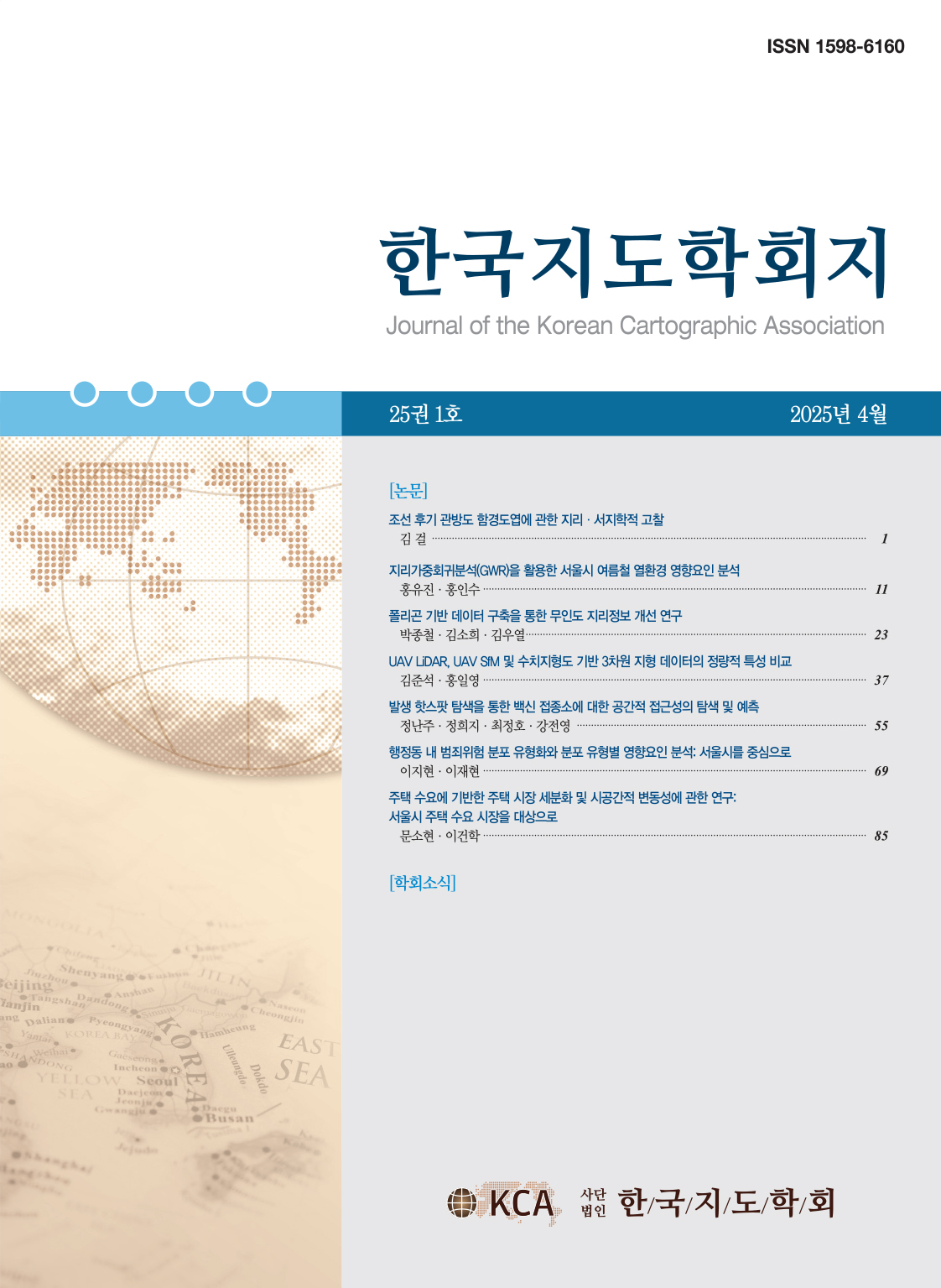Research Article
Abstract
References
Information
This study examines the geographical distribution and residential segregation of Koreans in Auckland using the 2013, 2018, and 2023 census data. The segregation levels of Koreans were measured using the index of dissimilarity and exposure index, and several residential clusters were identified using choropleth maps and the local G statistics. The results show that while the residential distribution of Koreans in Auckland maintains distinct clusters, particularly in the northern region, some expansion has also been observed. The level of segregation has been decreased slightly over the years, but separation from Māori and Pacific peoples remained relatively high. These findings contribute to the understanding of the Korean communities in Auckland, New Zealand and provide valuable insights for future predictions of how minority groups with similar initial settlement patterns and population sizes may evolve.
본 연구는 2013년, 2018년, 2023년 뉴질랜드 인구주택총조사 데이터를 활용하여 오클랜드 한인의 지리적 분포와 거주지 분리 변화를 분석한다. 연구에서는 단계구분도와 국지적 G 통계량을 활용하여 주요 거주지 군집의 변화를 살펴보고, 상이지수와 노출지수를 통해 한인의 분리 수준을 다른 민족과 비교하고자 한다. 결과적으로, 오클랜드 한인의 거주지 분포는 북부 지역을 중심으로 뚜렷한 군집 형태를 유지하면서도 동남부와 중부에서는 지역적 확산이 나타나는 등 공간적 재구성이 관찰되었다. 이러한 연구 결과는 오클랜드 내 한인 거주지 군집의 특성과 분리 수준 변화에 관한 기초 자료로 활용할 수 있고, 향후 유사한 인구 규모와 초기 정착 분포를 보이는 소수 집단이 어떻게 변화할지 예측하는데 중요한 시사점을 제공할 것으로 기대된다.
- 윤홍기・임석회, 1997, “뉴질랜드 오클랜드지역 한국인의 생업 분석,” 대한지리학회지, 32(4), 491-510.
- Anselin, L., 1995, Local indicators of spatial autocorrelation—LISA, Geographical Analysis, 27, 93-115. https://doi.org/10.1111/j.1538-4632.1995.tb00338.x10.1111/j.1538-4632.1995.tb00338.x
- Bedford, R., Ho, E., and Lidgard, J., 2000, International migration in New Zealand: Context, components and policy issues, Discussion Papers.
- Damm, A., 2009, Determinants of recent immigrants’ location choices: quasi-experimental evidence, Journal of Population Economics, 22(1), 145-174. https://doi.org/10.1007/s00148-007-0148-510.1007/s00148-007-0148-5
- Department of Statistics, 1986, The New Zealand official year-book 1986-1987, Wellington: N.Z. Govt. Printer.
- Duncan, O.D. and Duncan, B., 1955, Residential distribution and occupational stratification, The American Journal of Sociology, 60(5), 493-503. https://doi.org/10.1086/22160910.1086/221609
- Getis, A. and Ord, J.K., 1992, The analysis of spatial association by use of distance statistics, Geographical Analysis, 24, 189-206. https://doi.org/10.1111/j.1538-4632.1992.tb00261.x10.1111/j.1538-4632.1992.tb00261.x
- Grbic, D., Ishizawa, H., and Crothers, C., 2010, Ethnic residential segregation in New Zealand, 1991-2006, Social Science Research, 39(1), 25-38. https://doi.org/10.1016/j.ssresearch.2009.05.00310.1016/j.ssresearch.2009.05.003
- Ho, E. and Bedford, R., 2006, The Chinese in Auckland : changing profiles in a more diverse society. In W. Li (Ed.), From urban enclave to ethnic suburb : new Asian communities in Pacific Rim countries (pp. x, 278 p.). University of Hawai’i Press.
- Hong, S.-Y. and Yoon, H.-k., 2014, Ethno-economic satellite: the case of Korean residential clusters in Auckland, Population, Space and Place, 20(3), 277-292. https://doi.org/10.1002/psp.176410.1002/psp.1764
- Ip, M. and Friesen, W., 2001, The new Chinese community in New Zealand: local outcomes of transnationalism, Asian and Pacific Migration Journal, 10(2), 213-240. https://doi.org/10.1177/01171968010100020110.1177/011719680101000201
- Ip, M., 2003, Chinese immigrants and transnationals in New Zealand: a fortress opened. In L. J. C. Ma and C. Cartier (Eds.), The Chinese Diaspora: Space, Place, Mobility, and Identity (pp. viii, 400 p.). Lanham: Rowman & Littlefield.
- Johnston, R., Poulsen, M., and Forrest, J., 2008, Asians, Pacific Islanders, and ethnoburbs in Auckland, New Zealand, Geographical Review, 98(2), 214 (228). https://doi.org/10.1111/j.1931-0846.2008.tb00297.x10.1111/j.1931-0846.2008.tb00297.x
- Massey, D.S. and Denton, N.A., 1988, The dimensions of residential segregation, Social Forces, 67(2), 281-315. https://doi.org/10.1093/sf/67.2.28110.1093/sf/67.2.281
- Ongley, P. and Pearson, D., 1995, Post-1945 international migration: New Zealand, Australia and Canada compared, International Migration Review, 29(3), 765-793. https://doi.org/10.1177/01979183950290030810.1177/01979183950290030812291057
- Poulsen, M., Johnston, R., and Forrest, J., 2000, Ethnic enclaves in New Zealand?, International Journal of Population Geography, 6(5), 325-347. https://doi.org/10.1002/1099-1220(200009/10)6:5<325::AID-IJPG195>3.0.CO;2-I10.1002/1099-1220(200009/10)6:5<325::AID-IJPG195>3.0.CO;2-I
- Reardon, S.F. and O’Sullivan, D., 2004, Measures of spatial segregation, Sociological Methodology, 34(1), 121-162. https://doi.org/10.1111/j.0081-1750.2004.00150.x10.1111/j.0081-1750.2004.00150.x
- Waldinger, R., 1989, Immigration and Urban Change, Annual Review of Sociology, 15, 211-232. https://doi.org/10.1146/annurev.so.15.080189.00123510.1146/annurev.so.15.080189.00123512316381
- Yoon, H.-k., 2003, Recent East Asian immigrants and their contribution to multi-culturalism in Auckland, New Zealand, Human Geography (Jinbun-Chiri), 55(3), 95-106.10.4200/jjhg1948.55.293
- Statistics New Zealand, 2020, Ethnicity New Zealand Standard Classification 2005, https://aria.stats.govt.nz/aria/#ConcordanceView:uri=http://stats.govt.nz/cms/ConcordanceVersion/T0grb8wGQguRaGlB
- Statistics New Zealand, 2023, 2023 Census, https://www.stats.govt.nz/2023-census/
- Statistics New Zealand, 2024, Aotearoa Data Explorer, https://www.stats.govt.nz/tools/aotearoa-data-explorer/
- Publisher :The Korean Cartographic Association
- Publisher(Ko) :한국지도학회
- Journal Title :Journal of the Korean Cartographic Association
- Journal Title(Ko) :한국지도학회지
- Volume : 24
- No :3
- Pages :75~84
- DOI :https://doi.org/10.16879/jkca.2024.24.3.075



 Journal of the Korean Cartographic Association
Journal of the Korean Cartographic Association





